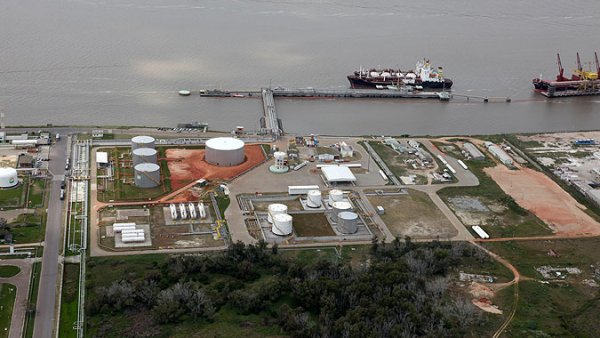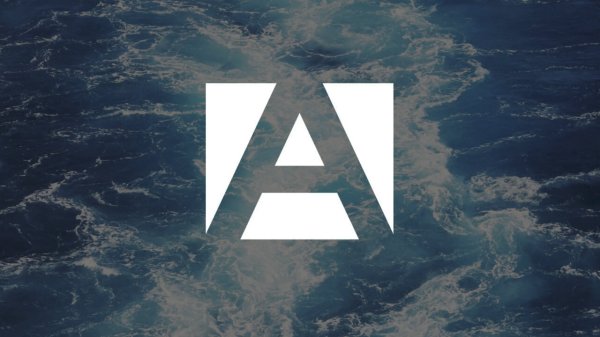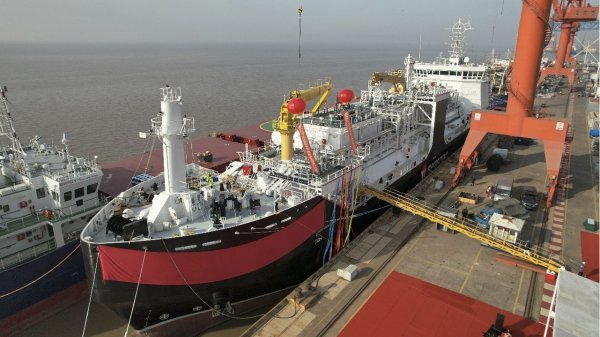Brightoil posts H2 revenue growth, lower bunker sales
Revenue growth was mainly thanks to an increase in sales from trading petroleum products.
Hong Kong-listed Brightoil Petroleum (Holdings) Ltd reports that the 44 percent growth in revenue during the second half of 2016 was mainly due to an increase in sales of petroleum products from international trading, as well as higher oil prices.
Total revenue for the group was HK$31,257 million ($4,028 million), up from HK$21,649 million ($2,790 million) during the corresponding six-month period in 2015.
Revenue for the company's International Trading and Bunkering (ITB) division - which includes both sales of petroleum products from international trading and revenue from marine bunkering - rose by HK$9,940 million ($1,281 million), or 49.9 percent, to HK$29,855 million ($3,848 million).
Sales of petroleum products from international trading increased by HK$10,436 million ($1,344.9 million), or 60.5 percent, to HK$27,685 million ($3,567.8 million), up from HK$17,249 ($2,222.9 million) in 2015.
However, revenue from marine bunkering actually declined by HK$531 million, or 20.9 percent, from HK$2,539 ($327.2 million) during the last six months of 2015 to HK$2,008 million ($258.8 million) during the same period in 2016.
Brightoil's gross profit rose by HK$549 million ($70.8 million), or 82.6 percent, to HK$1,214 million ($156.5 million).
Earnings before interest, taxes, depreciation, and amortization (EBITDA) increased from HK$761 million ($98.1 million) to HK$1,465 million ($188.8 million), representing an increase of 93 percent compared to the same period in 2015.
The EBITDA increase was said to be mainly thanks to the ITB and upstream segments; ITB recorded an EBITDA rise of 110 percent, from HK$232 million ($29.9 million) to HK$488 million ($62.9 million).
Due to lower freight rates, however, Brightoil's marine transportation business recorded an EBITDA of HK$216 million ($27.8 million), which was a decrease of 50 percent on the HK$433 million ($55.8 million) seen during the last half of 2015.
Profit after tax between July and December amounted to HK$412 million ($53.1 million), compared to a loss of HK$523 million ($67.4 million) during the prior-year period.
As previously reported, in 2016 Brightoil was one of three companies to break into Singapore's list of top 20 bunker suppliers by volume in 2016, with the company rising five places to 18th.
According to the Maritime and Port Authority of Singapore's (MPA) list of licensed bunker tankers, Brightoil currently has five vessels that have been approved for mass flow meter bunkering; they are: the Brightoil 688 (approved on 10th October 2014), the Brightoil 666 (approved on 16th April 2015), the Brightoil 639 (approved on 28th January 2016), the Brightoil 329 (approved on 5th December 2016) and the Brightoil 326 (approved on 28th December 2016). A sixth bunker tanker, the Brightoil 319, also operates in Singapore.
Brightoil says that in recent years its bunkering business has achieved "considerable" savings in operating costs and managed to increase profit margins via a light asset operation resulting from "resource optimization as well as the cooperation of our experienced trading and execution teams".
Additionally, the company says that oil price fluctuations have "brought new trading opportunities in the market".
"Through macroeconomic analysis and massive data-based research, the group's trading team has actively captured market opportunities and created profits for the group," Brightoil added.
Total revenue for the group was HK$31,257 million ($4,028 million), up from HK$21,649 million ($2,790 million) during the corresponding six-month period in 2015.
Revenue for the company's International Trading and Bunkering (ITB) division - which includes both sales of petroleum products from international trading and revenue from marine bunkering - rose by HK$9,940 million ($1,281 million), or 49.9 percent, to HK$29,855 million ($3,848 million).
Sales of petroleum products from international trading increased by HK$10,436 million ($1,344.9 million), or 60.5 percent, to HK$27,685 million ($3,567.8 million), up from HK$17,249 ($2,222.9 million) in 2015.
However, revenue from marine bunkering actually declined by HK$531 million, or 20.9 percent, from HK$2,539 ($327.2 million) during the last six months of 2015 to HK$2,008 million ($258.8 million) during the same period in 2016.
Brightoil's gross profit rose by HK$549 million ($70.8 million), or 82.6 percent, to HK$1,214 million ($156.5 million).
Earnings before interest, taxes, depreciation, and amortization (EBITDA) increased from HK$761 million ($98.1 million) to HK$1,465 million ($188.8 million), representing an increase of 93 percent compared to the same period in 2015.
The EBITDA increase was said to be mainly thanks to the ITB and upstream segments; ITB recorded an EBITDA rise of 110 percent, from HK$232 million ($29.9 million) to HK$488 million ($62.9 million).
Due to lower freight rates, however, Brightoil's marine transportation business recorded an EBITDA of HK$216 million ($27.8 million), which was a decrease of 50 percent on the HK$433 million ($55.8 million) seen during the last half of 2015.
Profit after tax between July and December amounted to HK$412 million ($53.1 million), compared to a loss of HK$523 million ($67.4 million) during the prior-year period.
As previously reported, in 2016 Brightoil was one of three companies to break into Singapore's list of top 20 bunker suppliers by volume in 2016, with the company rising five places to 18th.
According to the Maritime and Port Authority of Singapore's (MPA) list of licensed bunker tankers, Brightoil currently has five vessels that have been approved for mass flow meter bunkering; they are: the Brightoil 688 (approved on 10th October 2014), the Brightoil 666 (approved on 16th April 2015), the Brightoil 639 (approved on 28th January 2016), the Brightoil 329 (approved on 5th December 2016) and the Brightoil 326 (approved on 28th December 2016). A sixth bunker tanker, the Brightoil 319, also operates in Singapore.
Brightoil says that in recent years its bunkering business has achieved "considerable" savings in operating costs and managed to increase profit margins via a light asset operation resulting from "resource optimization as well as the cooperation of our experienced trading and execution teams".
Additionally, the company says that oil price fluctuations have "brought new trading opportunities in the market".
"Through macroeconomic analysis and massive data-based research, the group's trading team has actively captured market opportunities and created profits for the group," Brightoil added.

|
IMO approves pricing mechanism based on GHG intensity thresholds
Charges to be levied on ships that do not meet yearly GHG fuel intensity reduction targets. |
|
|
|
||

|
VARO Energy expands renewable portfolio with Preem acquisition
All-cash transaction expected to complete in the latter half of 2025. |
|
|
|
||

|
NYK trials biofuel in milestone coal carrier test
Vessel is used to test biofuel for domestic utility company. |
|
|
|
||

|
H-Line Shipping orders LNG bunkering vessel
Vessel with 18,000-cbm capacity to run on both LNG and MDO. |
|
|
|
||

|
How to engineer and manage green shipping fuels | Stanley George, VPS
Effective management strategies and insights for evolving fuel use. |
|
|
|
||

|
Swedish government bans scrubber wastewater discharges
Discharges from open-loop scrubbers to be prohibited in Swedish waters from July 2025. |
|
|
|
||

|
MAN Energy Solutions achieves 100% load milestone for ammonia engine
Latest tests validate fuel injection system throughout the entire load curve. |
|
|
|
||

|
Petrobras secures ISCC EU RED certification for B24 biofuel blend at Rio Grande
Blend consisting of 24% FAME is said to have been rigorously tested to meet international standards. |
|
|
|
||

|
Stolt-Nielsen to fully control Avenir LNG with acquisition
Share purchase agreement to buy all shares from Golar LNG and Aequitas. |
|
|
|
||

|
Bureau Veritas supports launch of CIMC SOE's LNG bunkering vessel
Handover of Seaspan Energy's cutting-edge 7,600-cbm vessel completed. |
|
|
|
||
Related Links
- · Brightoil to hold board meeting to approve H2 results [Insights]
- · Bunker growth helps Brightoil achieve unaudited profit rise [Insights]
- · Chemoil named Singapore's top bunker supplier for second year in a row [Insights]
- · Hong Kong [Directory]

